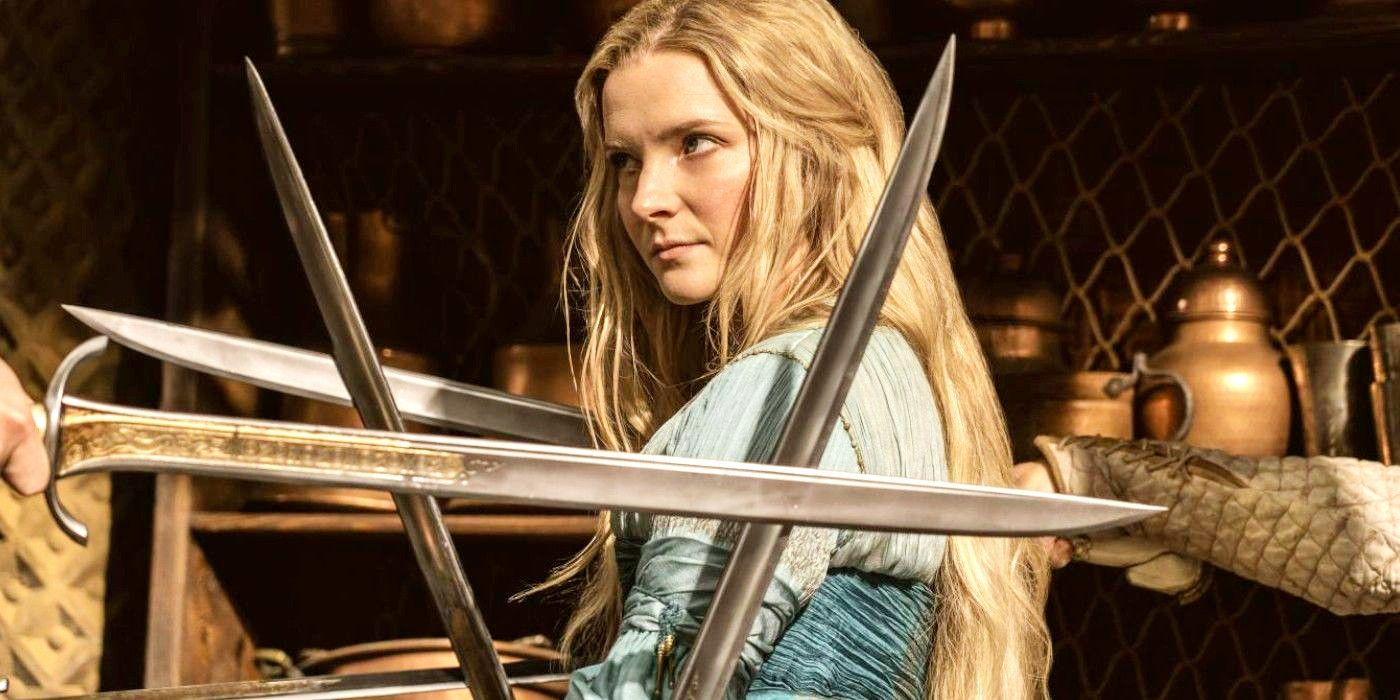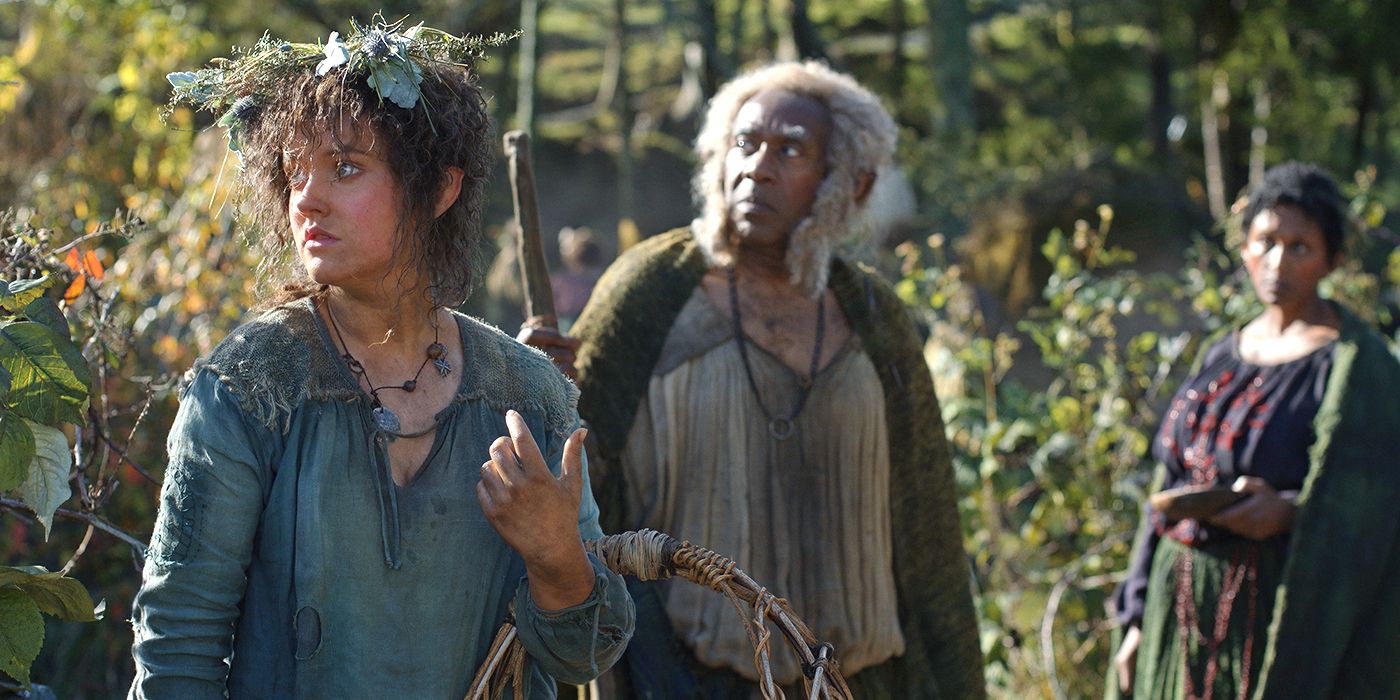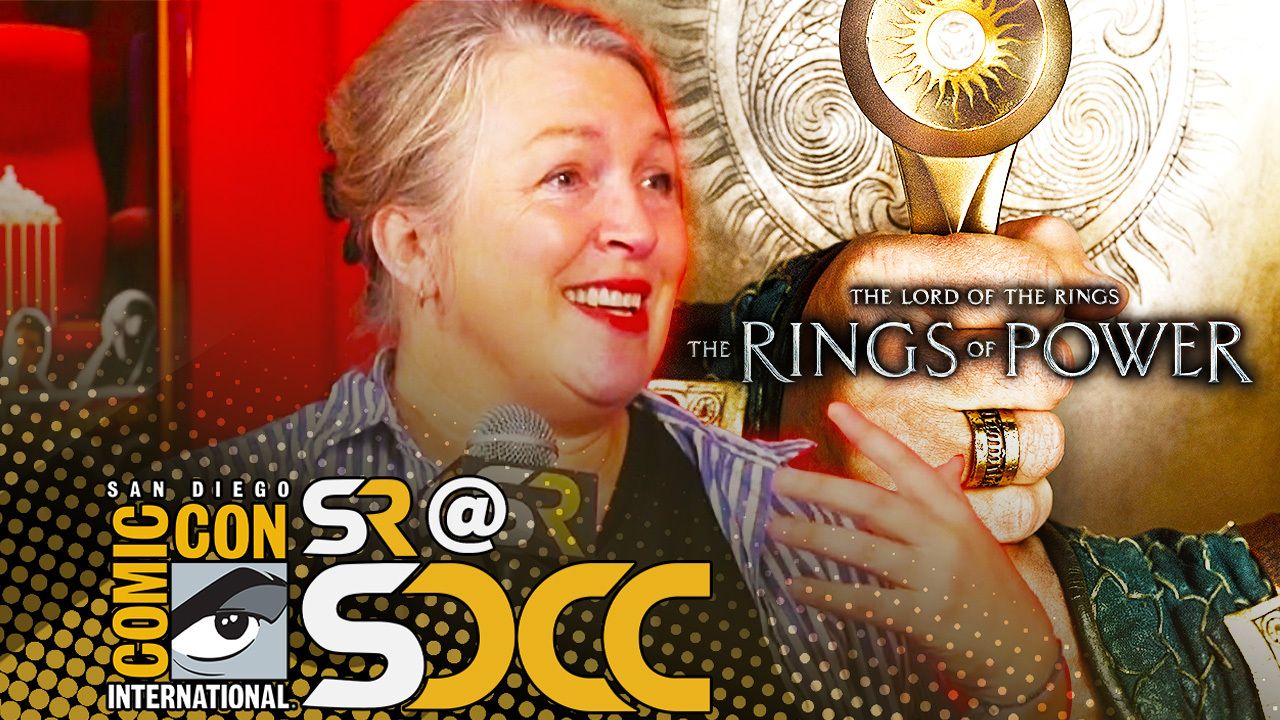Summary
- The costume design for The Lord of the Rings: The Rings of Power has been recognized with an Emmy nomination for Outstanding Fantasy/Sci-Fi Costumes.
- The creative team faced the challenge of not only creating looks for familiar characters like Galadriel and Elrond, but also crafting costumes for proto-cultures in the Second Age of Middle-earth.
- Costume designer Kate Hawley drew inspiration from nature and incorporated elements like stars, water, and light to reflect the different civilizations and characters in the series. The costumes aim to create a raw and classical image while staying true to Tolkien’s descriptions.
The Lord of the Rings: The Rings of Power season 2 is some time away, but season 1 of Prime Video’s J.R.R. Tolkien adaptation is basking in the glow of recent Emmy nominations. Among its 6 nods sits one for Outstanding Fantasy/Sci-Fi Costumes, for designer Kate Hawley and her team. Naturally, costumes are an important aspect of world-building for any fantasy series, and The Rings of Power has the added pressure of Tolkien’s legacy and Peter Jackson’s movies to live up to.
The Rings of Power is set in the Second Age of Middle-earth, meaning its plot unfolds thousands of years before The Lord of the Rings. True to its name, season 1 builds toward the creation of Sauron’s One Ring while serving as a precursor to the epic novel and movie trilogy. While characters such as Galadriel and Elrond maintain the thread of continuity with the Third Age, the creative team behind Prime Video’s show was tasked with not only crafting looks for their younger selves but also creating proto-cultures such as the Harfoots and the humans of the Southlands.
caught up with Hawley while at San Diego Comic-Con about her work on The Lord of the Rings: The Rings of Power, how she incorporates research and environment in her costumes, and her recurring collaborations with director Guillermo del Toro.
Kate Hawley Talks The Lord of the Rings: The Rings of Power
: We’re here with Kate Hawley, costume designer from The Lord of the Rings: The Rings of Power, and a recent Emmy nominee. Congratulations!
Kate Hawley: I know, thank you. I was saying to [my publicist], “Oh, yeah. I woke up to everybody going, ‘Hey. Guess what? You’ve got one.’” So, it was a lovely surprise. I think most artists and creatives sort of always deal with sort of, “I’ve been found out,” like it’s a fraud thing. But it’s a lovely thing to be nominated, for sure.
I have to say, you have done work on some of my favorite projects from all different kinds of genres, like Crimson Peak and Pacific Rim. What is your general approach to an expansive work? Because all of those are projects that are really fully immersed in a different world of some kind.
Kate Hawley: Yeah. I think that’s what I realized quite late, that that’s actually… It’s not necessarily what the project is. It’s not necessarily the time period. And that I worked out early on that the world building is something I especially love and the directors that I’m working with. It’s so much part of the chemistry. It’s like a marriage of kind. But I love the world building. I’ve always been one of those kids that had my head buried in fantasy books – and particularly Lord of the Rings and Ursula K. Le Guin and all of those wonderful writers – just to have this other reality, which I think taps into our environment and world and ritual. And I think people need that in their lives.
My approach generally is that doesn’t matter what’s written on the page. It’s the process. Well, it does matter, but it’s the process of who you’re working with and that chemistry and then the world-building follows from that. And I approach it from all kinds of levels, from the dream time of it to the real research, where it is in the context of the world and the character. That’s a lot short version, but you’re almost like a forensic detective, whatever world you’re in. When I was in the world of Suicide Squad, I read all the DC comics; all the ones talking about Harley Quinn. Lord of the Rings? Same thing. I mean, that’s massive tomes to get through.
But you have to do your due diligence and immerse yourself, and somewhere through that into the ether comes where you’re going. Obviously, in this case, showrunners and in other cases, your director, have their vision. We all come to the project with interpretations of things, and then it’s about the collaboration and how you work through to see the vision that’s wanted.

And you get to be something of an anthropologist, especially with Lord of the Rings, because it’s like, “Oh, look at this civilization that came right before the one you know about.”
Kate Hawley: We had massive amounts of research, but inevitably it would be, “It’s a star.” What is the symbol? It would be a star. But you have to do that. And then it’s understanding who your actors are and why they’ve been cast and allowing that interpretation, particularly in this world. We’re in a different age. We’re not in the Third Age. So our characters are not 6,000 years old when it comes to the elves. They’re more like 3,000.
And some people say, “Oh, they never change,” but I do think one perspective of looking at this is that elves have had the knowledge of 6,000 years to grow up and learn and accept their faults. In The Silmarillion, more like Greek gods. They make mistakes. They’re not without fault. And I think that’s a wonderful way to look at that. They’re not perfect beings. It’s a much more sort of in line with the Greek mythologies and things where they did terrible things to each other in the First Age. And so we’re sitting in an interesting place where they haven’t yet become the people we know in the Third Age and dearly loved. And I think it’s quite a difficult thing to balance that journey, because when we read the Lord of the Rings book, it’s so complete and in this world, it isn’t and has a very different tone, but you still have to find somewhere that allows people to relate to it. Otherwise, it doesn’t feel like that.
It’s something you’re always trying to balance. I don’t think the work’s ever complete. And I still look back at other projects and go, “Ah, I should’ve, could’ve done this or…” It’s never-ending. There’s so many choices. How many versions of that Shakespeare Macbeth that you’ve seen amazing interpretations of and all are interesting and have different points. So I think it’s quite an interesting process. Yeah.
You mentioned the elves, and I feel like they’re really the characters that we know in their future. But how do you really get into the specifics of like, “This is where Galadriel is?” You’ve mentioned movement and sound are all really significant aspects of building that character. How do you incorporate that into the design of her costumes and her own evolution throughout the season?
Kate Hawley: We had to understand the Second Age that we’re in. You had to look at where the character falls in the Third Age. And she’s a lady, the Lady of Lothlorien. And then we look in the First Age where she’s come from. So you have to kind of look at the character arc on a scale of 6,000 years and then you sort of… And very much it was working off the script. So the script as it developed depicted Galadriel this way. And so my job is to interpret that and work with our actress because they all come with their own physicality, interpretations. And so you work closely with that. And this, we had moments where there were still elements where she evoked a little bit of the great lady, so we might see a tiny bit of that to come, but there’s a greater physicality with this Galadriel.
And so we had to work hard to find moments that still became our kind of magic, because the showrunners wanted a different… That word, magic, is a big thing. And I think it’s constantly a balance to try and achieve it. But in this world, they wanted them to feel very real. And it felt more like a Court of King Arthur where people fall on their swords. They’re not perfect beings at all. But also we use a lot of references from Valinor and a whole imagery Tolkien has of those heroes with stars reflected on their arraignment and born on shores of pearls. And we took all of these images and worked it in trying to use the images of water and stars and light. And it’s all in Tolkien’s language. Every time he depicts a character or references it, there’s not a lot of, “They wore this,” but there’s a lot of, “His cloak reflects this.”
It’s a very organic process and we try to create light with the costumes and reflect it and have a more organic texture and relate all of these characters, not just the elves, but all of them back within their materiality of the worlds as Tolkien described them. And they’re slightly different from what we’ve seen before, but it was a trying to achieve a rawer, more classical image.

You’ve talked about being inspired by nature in the process of development. There’s certain aspects that really are like you feel the nature reflected in the costumes, especially the Harfoots, who are nomads, and that you see them traveling in their environment.
Kate Hawley: Well, it’s atmosphere too. When I say we based it in nature, Tolkien was all about that, Tolkien’s work. And so we actually did an exercise, how do you tackle something this big, and it can get overwhelming. So we treated it with broad brush strokes at the beginning. And we had this concept room. It was a locked room. And we had tables everywhere. And each culture had its own environment set up. And we would add textures. We had stones and semi-precious stones for the dwarfs and scorched earth and elements for that. And for the Harfoots, we had berries and we looked at dyes and vegetable dyes. So we started to build up the world of each culture and race. And then we were able to see the distinctions between them, because it’s like a giant mapping that has to happen.
And the Harfoots, that image of them being these sort of nomadic people, but some of the colorings, the greens and that still echoed where we end up in the Shire and there’s something that’s still got to be… They’re Harfoots. There’s still got to be that Hobbity thing. But we wanted these guys to feel wilder and more elemental in that. So there was a lot of almost sort of Tchaikovsky treatment where it’s a bit more in the elements really, I guess.
Now you’ve left kind of a path for future generations of costume designers on the Rings of Power. But what are some of the top three elements that just have to be included every season from now on?
Kate Hawley: Oh, that’s a big answer. Stars. I mean, the elves stayed constant. And it’s the place we’re in at the beginning was Bayona and Patrick and JD wanted this to be the golden age of elves and dwarfs. So, I guess there’s certain elements that… I mean, are our Harfoots and Hobbits ever Harfoots and Hobbits without that element of green and nature and their ancestors and that? I guess there’s certain elements like the stars with the elves that would stay constant in that world, but they’ve got a massive evolution over five seasons. A lot of work.
I mentioned Crimson Peak earlier. And I loved your work with Guillermo del Toro. He’s stepping into the MonsterVerse with Frankenstein. Is it true that you are a part of that?
Kate Hawley: It could be. Yes.
What vision would you share with him for Frankenstein?
Kate Hawley: I think it’s usually the other way around. The director shares their vision. Look, it’s always playtime with Guillermo, so it’s a joy to be part of that.
About The Lord of the Rings: The Rings of Power

Prime Video’s The Lord of the Rings: The Rings of Power brings to screens for the very first time the heroic legends of the fabled Second Age of Middle-earth’s history. This epic drama is set thousands of years before the events of J.R.R. Tolkien’s The Hobbit and The Lord of the Rings, and will take viewers back to an era in which great powers were forged, kingdoms rose to glory and fell to ruin, unlikely heroes were tested, hope hung by the finest of threads, and the greatest villain that ever flowed from Tolkien’s pen threatened to cover all the world in darkness.
Beginning in a time of relative peace, the series follows an ensemble cast of characters, both familiar and new, as they confront the long-feared re-emergence of evil to Middle-earth. From the darkest depths of the Misty Mountains, to the majestic forests of the elf-capital of Lindon, to the breathtaking island kingdom of Númenor, to the furthest reaches of the map, these kingdoms and characters will carve out legacies that live on long after they are gone.
Check out our interviews with The Lord of the Rings: The Rings of Power cast here:
The Lord of the Rings: The Rings of Power season 1 is now streaming on Prime Video.
